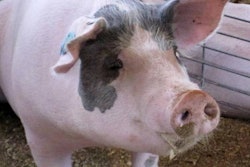
Video tours of pig, poultry and other livestock farms could serve both animal welfare activists and pork producers. The farmers and activists both hope to raise awareness of the conditions farm animals live in, but with opposite end goals.
While the activists frame the videos as exposing animal suffering, Fair Oaks Farms, a large-scale, working agritourism farm, plans to use video tours to allow more people to view the inside of their farm, without needing to travel or expose animals to outside diseases.
Animal welfare activists use video of pig, poultry and dairy farms
Animal rights group Animal Equity used a specialized camera to shoot immersive video of pig, dairy and poultry operations, called iAnimal. The videos allow viewers to pan 360 degrees, as well as up and down, to view the entire scene within the animal operations.
The videos feature emotional narration that disparages the animal husbandry practices viewers see, such as gestation and farrowing crates. The videos include footage of dead piglets and the castration of male piglets.
Pig, dairy, egg farm preparing to use video tours
On the end of the spectrum, Gary Corbett, CEO of Fair Oaks Farms, told WATTAgNet that his facility is working to create a video-based virtual tour of their facilities. The video tours will allow people to watch what’s going on inside the farm, without having to make the trip to Indiana, USA.
Currently hundreds of thousands of people, many of them school children, tour the farm each year and get a first-hand look at pig farming. Visitors are kept separate from the animals for biosecurity reasons. However, there are opportunities to ask questions of farm workers while viewing a newborn piglet. Yet there is a limit to how many people can tour the facility and afford to travel to get there. Videos could allow Fair Oaks to showcase their practices to a wider audience.
Other types of animal cams, such as live video feeds of eagles’ nests or cameras live-streaming animal births in zoos, already have gained popularity and are used by conservationists and zoo keepers to raise public interest and awareness. Likewise, Corbett plans for the cameras at Fair Oaks to serve as distance learning tools.
Providing a transparency model for animal agriculture
Fair Oaks Farms has chosen to tackle the biosecurity and public relations challenges of welcoming a half-million visitors each year to tour its 37,000-cow dairy, 3,000-sow farrow-to-wean farm and half-million cage-free laying hen farm, reported WATTAgNet in 2016.
Fair Oaks’ animal housing areas of the exhibition buildings are hermetically sealed from the visitor viewing areas. The air going into the animal buildings is filtered to remove contaminants that visitors could have brought with them.
The images and opinions formed at Fair Oaks Farms may help consumers put activists' images in perspective by giving consumers a point of reference. Corbett encouraged others in animal agriculture to follow the Fair Oaks example.
















